
Mushrooms in Lawn can be a surprising and potentially concerning sight for homeowners who take pride in maintaining a beautiful and healthy yard. While mushrooms are often an indicator of a healthy ecosystem, they can be unsightly and even dangerous if ingested by children or pets.
Understanding the reasons behind the appearance of mushrooms in lawns and how to safely and effectively remove them is essential for keeping your lawn in top condition.
Let’s explore the world of lawn mushrooms, including their types, characteristics, and how to manage them in your lawn or garden.
Types of Lawn Mushrooms
Common Types of Lawn Mushrooms
Fairy Ring Mushrooms
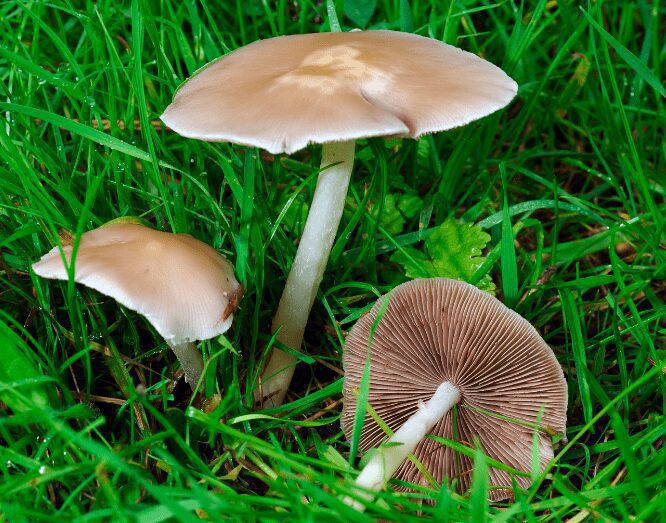
Fairy ring mushrooms are a type of fungi that are commonly found in lawns and grassy areas. They are named for their distinctive circular growth pattern, which can sometimes result in dead patches in the grass.
The circle can range from just a few inches to over 30 feet, and the mushrooms themselves can be pretty extensive, with caps up to 12 inches in diameter. Fairy ring mushrooms are typically tan or brown, with caps that are either smooth or slightly scaly.
Fairy ring mushrooms are saprophytic, meaning they obtain nutrients by breaking down dead organic matter in the soil. As they grow and spread, they release enzymes that break down the organic matter, which can form a hydrophobic barrier that can prevent water from penetrating the soil. This can lead to the development of brown, dead patches in the grass.
While fairy ring mushrooms are generally not harmful to humans or animals, they can be a nuisance for homeowners who want a pristine lawn. A few strategies for managing fairy ring mushrooms include improving soil drainage and aeration, removing thatch buildup, and using a fungicide to treat the affected area.
However, it is important to note that fairy ring mushrooms can be difficult to eradicate completely, and it may take some time and effort to see results.
Puffball Mushrooms
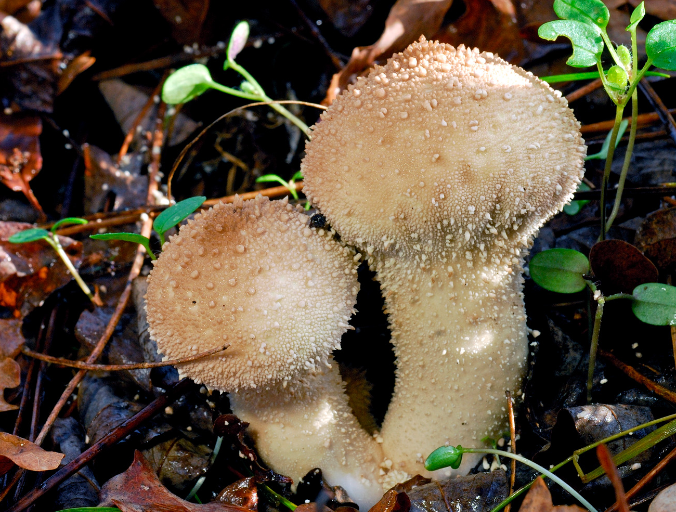
Puffball mushrooms are a type of fungi that are commonly found in lawns, meadows, and other grassy areas. They are named for their distinctive shape, resembling a cotton or fur ball when young, and they release spores when disturbed.
Puffballs can vary in size from just a few inches in diameter to over a foot across, and they can be white, tan, or brown.
Puffball mushrooms are saprophytic, meaning they obtain nutrients by breaking down dead organic matter in the soil. As they grow, they release enzymes that break down the organic matter, helping to enrich the soil.
Puffballs are generally not harmful to humans or animals, although some puffball species can cause an allergic reaction in sensitive individuals.
Puffballs can be a fascinating and beautiful addition to a lawn or garden, but they can also be a nuisance for homeowners who want a pristine lawn. If left unchecked, puffballs can spread and create unsightly brown patches in the grass.
To manage puffball mushrooms, it is important to mow your lawn regularly to prevent the mushrooms from producing spores, which can help to limit their spread. If you have a particularly large or persistent infestation of puffball mushrooms, you may need to use a fungicide to treat the affected area.
However, it is always best to consult a professional before using any chemicals in your lawn or garden.
Stinkhorn Mushrooms
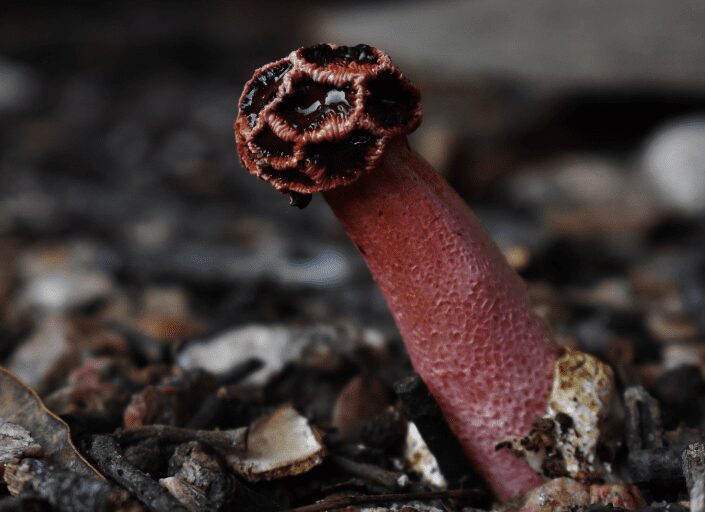
Stinkhorn mushrooms are a type of fungi that are commonly found in lawns and other outdoor areas. They are named for their distinctive, unpleasant odor, likened to the smell of rotting flesh.
Stinkhorn mushrooms come in various shapes and sizes, but they are generally tall and thin with a phallic shape that can be pretty striking. Some species of stinkhorn mushrooms are brightly colored, with pink, orange, or red caps.
Stinkhorn mushrooms are saprophytic, meaning they obtain nutrients by breaking down dead organic matter in the soil. As they grow, they release enzymes that break down the organic matter, helping to enrich the soil.
Stinkhorn mushrooms are generally not harmful to humans or animals, although they can be a nuisance for homeowners who find the odor and appearance of the mushrooms unpleasant.
To manage stinkhorn mushrooms, it is important to remove any dead organic matter from your lawn or garden, as this is the primary source of nutrients for the mushrooms. You can also mow your lawn regularly to prevent the mushrooms from producing spores, which can help to limit their spread.
In some cases, it may be necessary to use a fungicide to treat the affected area, but it is always best to consult with a professional before using any chemicals in your lawn or garden.
Edible Lawn Mushrooms
Morel Mushrooms
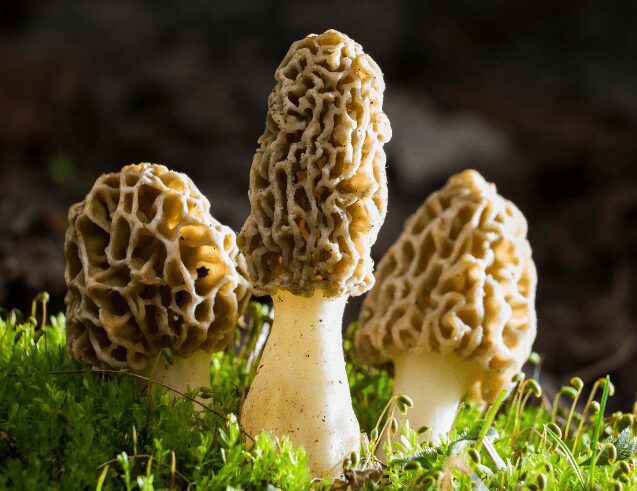
Morel mushrooms are a type of edible fungi that are highly prized for their delicious flavor and unique appearance. They are typically found in wooded areas, but they can also be found in lawns, gardens, and other grassy areas.
Morels are characterized by their distinctive shape, which resembles a honeycomb with a hollow stem. They can range in color from light tan to almost black, and their caps can be smooth or wrinkled.
Morel mushrooms are mycorrhizal, meaning they have a symbiotic relationship with certain types of trees and other plants. The fungi provide the plants with nutrients, while the plants provide the fungi with carbohydrates. Morels are typically found in areas with a high concentration of dead or decaying organic matter, such as fallen leaves, branches, or tree stumps.
Morel mushrooms are a delicacy in many parts of the world and often used in gourmet cuisine. However, it is essential to note that some species of morel mushrooms can be toxic, and it is essential to correctly identify the mushrooms before consuming them.
If you are not an experienced forager, purchasing morels from a reputable supplier is best rather than attempting to collect them on your own. Additionally, cooking morel mushrooms thoroughly before eating them is essential to avoid any potential health risks.
Chicken Of The Woods
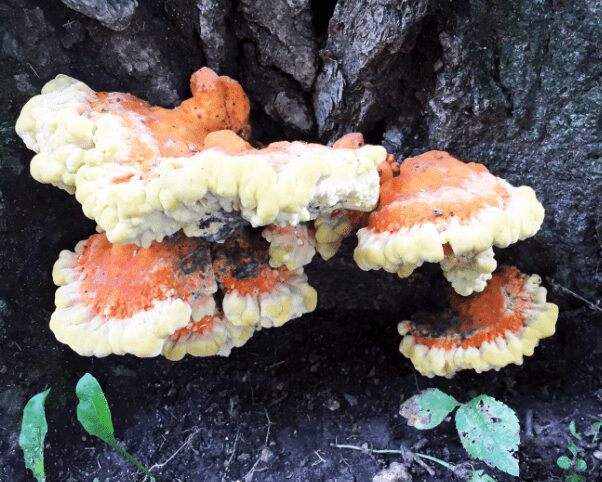
Chicken of the Woods is an edible mushroom prized for its delicious flavor and meaty texture. It is commonly found on hardwood trees, particularly oak trees, and it can range in color from bright orange to yellow or salmon pink. Chicken of the Woods gets its name from its texture, similar to that of chicken or other types of poultry.
Unlike many other types of mushrooms, Chicken of the Woods is not mycorrhizal, meaning it has no symbiotic relationship with trees or other plants. Instead, it is a saprophyte, which obtains nutrients by breaking down dead organic matter. Chicken of the Woods can often grow on dead or dying trees, decaying logs, and stumps.
Chicken of the Woods is a popular edible mushroom often used as a meat substitute in vegetarian and vegan dishes. It can be sautéed, roasted, or grilled, and it is known for its ability to absorb flavors and seasonings.
However, it is essential to correctly identify Chicken of the Woods before consuming it, as some mushroom species can cause adverse reactions in some people. Additionally, avoiding harvesting Chicken of the Woods from trees treated with pesticides or other chemicals is crucial.
Oyster Mushrooms
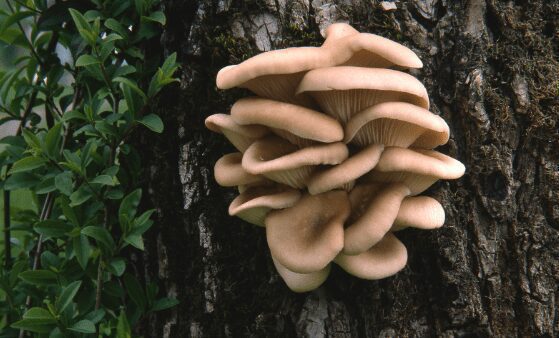
Oyster mushrooms are a type of edible fungi that are prized for their delicate flavor and velvety texture. They are named for their distinctive shape, resembling an oyster or a fan.
Oyster mushrooms grow on dead or decaying wood, particularly on deciduous trees such as oak, beech, and maple. They can range in color from white to gray, and their caps can be smooth or slightly wrinkled.
Oyster mushrooms are saprophytic, meaning they obtain nutrients by breaking down dead organic matter in the environment. They are often found growing on dead or dying trees but can also be grown commercially on straw or sawdust.
Oyster mushrooms are a popular edible mushroom often used in various dishes, including soups, stews, and stir-fries. They are known for their mild, nutty flavor and tender texture, which make them a favorite of many chefs and food enthusiasts. Oyster mushrooms are also low in calories and protein, making them a healthy addition to any diet.
In addition to their culinary uses, oyster mushrooms have also been studied for their potential health benefits. They are rich in antioxidants and beta-glucans, which may help to boost the immune system and reduce the risk of certain diseases.
However, it is vital to correctly identify oyster mushrooms before consuming them, as some species can cause adverse reactions in some people. Additionally, avoiding harvesting oyster mushrooms from trees treated with pesticides or other chemicals is important.
Are Mushrooms in Lawn Harmful to Your Lawn?
Do Lawn Mushrooms Kill Your Grass?
Lawn mushrooms are a common sight in many lawns and gardens, and while they may be unsightly, they do not typically threaten your grass’s health. Many types of lawn mushrooms can benefit your lawn, as they help break down dead organic matter and enrich the soil.
That being said, some species of lawn mushrooms can cause harm to your grass. For example, fairy ring mushrooms can create a hydrophobic barrier in the soil, developing brown, dead patches in the grass. In addition, some types of mushrooms can be toxic to pets or humans if ingested.
To manage lawn mushrooms, it is important to remove any dead organic matter from your lawn or garden, as this is the primary source of nutrients for the mushrooms. You can also mow your lawn regularly to prevent the mushrooms from producing spores, which can help to limit their spread.
If you have a particularly large or persistent infestation of lawn mushrooms, you may need to use a fungicide to treat the affected area. However, it is always best to consult with a professional before using any chemicals in your lawn or garden.
The Role of Mycelium in Lawn Health
Mycelium plays an important role in lawn health, as it helps to break down organic matter in the soil and distribute nutrients to the roots of plants. Mycelium is the vegetative part of a fungus, consisting of a network of delicate, thread-like structures known as hyphae. The hyphae spread through the soil, breaking down dead organic matter and releasing nutrients plants can take up.
One of the critical benefits of mycelium in lawn health is that it helps to create healthy, fertile soil. As the mycelium breaks down organic matter, it helps create a nutrient-rich soil essential for the growth of healthy grass and other plants.
In addition, mycelium can help improve soil structure and aeration, leading to better water retention and nutrient absorption.
Another vital role of mycelium in lawn health is that it can help to protect plants from diseases and pests. Mycelium can form a protective barrier around the roots of plants, helping to prevent harmful bacteria and other pathogens from attacking the plant.
Mycelium can also help to break down toxins and pollutants in the soil, making it a healthier environment for plants to grow.
To encourage mycelium growth in your lawn, it is crucial to maintain healthy soil and avoid using harmful chemicals and pesticides. You can also add organic matter to your lawn, such as compost or leaf litter, which can provide a food source for the mycelium.
By supporting mycelium growth in your lawn, you can help promote healthy, thriving plants and a more sustainable ecosystem.
How to Identify Harmful Lawn Mushrooms
Identifying harmful lawn mushrooms can be challenging, as many different types can grow in lawns and gardens. However, there are a few key characteristics that you can look for to help identify potentially poisonous mushrooms.
First, it is important to look at the cap of the mushroom. Some poisonous mushrooms have caps that are brightly colored, such as red, yellow, or orange, while others may have caps covered in scales or warts. It is also important to note the size and shape of the cap, as some poisonous mushrooms may have caps shaped like a bell or a cone.
Another vital characteristic to look for is the presence of gills or pores on the underside of the mushroom cap. Some poisonous mushrooms have gills that are brightly colored or produce a milky or sticky substance when broken.
It is also worth noting the mushroom’s location and growing pattern. Some harmful mushrooms, such as the death cap, are typically found near oak trees or other hardwoods. Other mushrooms, such as the destroying angel, may grow in a cluster or group.
If you are unsure about the identity of a mushroom growing in your lawn or garden, it is always best to err on the side of caution and avoid touching or consuming it. Some types of poisonous mushrooms can cause severe illness or even death, and it is important to seek medical attention if you have come into contact with a toxic mushroom.
If you suspect a large infestation of poisonous mushrooms in your lawn or garden, it is best to consult a professional to identify and treat the problem correctly.
Are Lawn Mushrooms Harmful to Pets
Some types of lawn mushrooms can harm pets, while others are relatively harmless. The toxicity of a lawn mushroom depends on the species of the mushroom, and some species can cause severe illness or even death in pets if ingested.
Pets, such as dogs and cats, may be attracted to the smell or appearance of mushrooms in the lawn or garden and may try to eat them. Supervising your pets when they are outside and removing any mushrooms from the lawn or garden to prevent accidental ingestion is essential.
If you suspect your pet has ingested a lawn mushroom, it is crucial to seek veterinary attention immediately. Symptoms of mushroom poisoning in pets can include vomiting, diarrhea, abdominal pain, lethargy, and seizures. In some cases, mushroom poisoning can be fatal if left untreated.
To minimize the risk of mushroom poisoning in pets, it is important to correctly identify and remove any potentially poisonous mushrooms from your lawn or garden. It is also a good idea to keep your pets away from areas where mushrooms are growing and supervise them closely when they are outside.
Suppose you have a persistent problem with lawn mushrooms and are concerned about the safety of your pets. In that case, it may be best to consult a professional to identify and manage the issue properly.
Common Toxic Lawn Mushrooms for Pets
Several types of toxic lawn mushrooms can be harmful to pets if ingested.
Here are some of the most common toxic lawn mushrooms for pets:
-
Amanita mushrooms
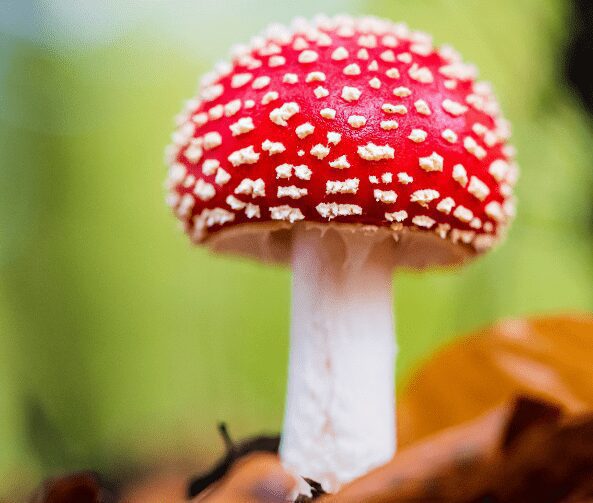
They are some of the most toxic and can cause severe illness or death in pets. They are typically found near oak or pine trees and have white gills and a distinctive cap.
2. Galerina mushrooms
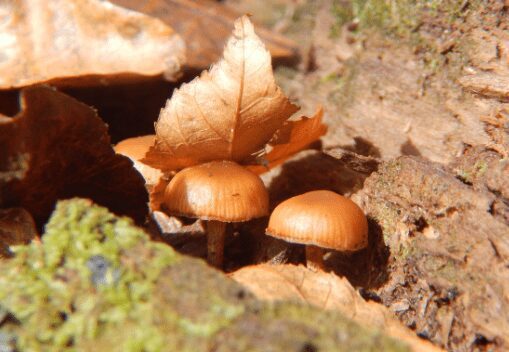
These small, brown mushrooms can be found growing on decaying wood or in grassy areas. They contain a toxin called amatoxin, which can cause pet liver failure.
3. Conocybe and Pholiotina mushrooms

These small, brown mushrooms have a distinctive cone-shaped cap and can contain the same toxin as Galerina mushrooms, which can cause liver failure in pets.
4. Inocybe mushrooms
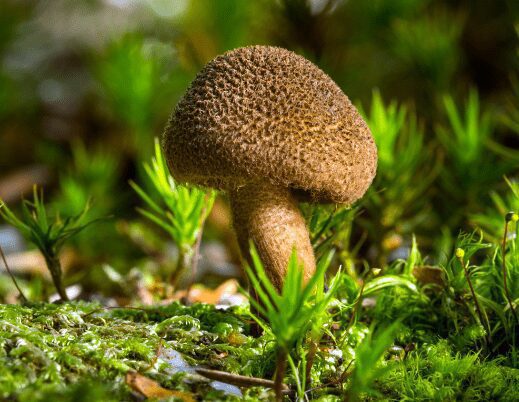
These mushrooms have a brown or yellow cap and can grow in lawns or meadows. They contain a toxin that can cause symptoms such as vomiting, diarrhea, and seizures in pets.
It is important to identify any mushrooms growing in your lawn or garden properly and to remove any potentially harmful mushrooms to prevent accidental pet ingestion.
If you suspect your pet has ingested a toxic mushroom, it is important to seek veterinary attention immediately. Early treatment can be crucial in preventing serious illness or death in pets.
Symptoms of Mushroom Poisoning in Pets
The symptoms of mushroom poisoning in pets can vary depending on the type of mushroom ingested, the amount consumed, and the size and health of the pet.
However, some common symptoms of mushroom poisoning in pets include:
- Vomiting: Pets that have ingested toxic mushrooms may experience vomiting, which can be frequent.
- Diarrhea: Pets may also experience diarrhea, which can be watery or bloody.
- Abdominal pain: Pets may show signs of abdominal pain, such as hunching over, refusing to eat, or vocalizing.
- Lethargy: Pets may become lethargic and weak and have difficulty standing or walking.
- Jaundice: Pets with liver damage from mushroom toxicity may develop yellowing of the skin, gums, and eyes.
- Seizures: In severe cases of mushroom poisoning, pets may experience seizures, tremors, or other neurological symptoms.
If you suspect your pet has ingested a toxic mushroom, it is crucial to seek veterinary attention immediately. Time is of the essence, as early treatment can be essential in preventing severe illness or death in pets.
Bringing a sample of the mushroom your pet ingested is also a good idea to assist with identification and treatment.
Removing and Preventing Lawn Mushrooms
How to Remove Mushrooms from Lawn Naturally
Manual Removal
One natural method for removing mushrooms from a lawn is manual removal. This involves physically removing the mushrooms by hand or with a small tool such as a trowel. When removing mushrooms by hand, it is essential to wear gloves to prevent any potential skin irritation or contact with toxic mushrooms.
To remove mushrooms from the lawn using a tool, gently dig around the base of the mushroom and pull it out by the stem, removing as much of the root system as possible. Be sure to dispose of the mushrooms and any associated soil or debris in a sealed bag or container to prevent the spread of spores.
Vinegar Solution
Another natural method for removing mushrooms from a lawn is to use a vinegar solution. Vinegar is an acidic substance that can help to kill mushrooms and prevent them from growing back.
To create a vinegar solution for removing mushrooms, mix one part white vinegar with two parts water in a spray bottle. Shake the bottle well to mix the solution, then spray it directly onto the mushrooms in your lawn. Be sure to thoroughly saturate the mushrooms with vinegar, covering the entire cap and stem.
It is important to note that vinegar can also harm your lawn and other plants, so it is important to use it sparingly and only on the affected areas. It is also essential to use a diluted solution of vinegar, as undiluted vinegar can be too harsh and may damage your lawn.
Baking Soda Solution
A baking soda solution is another natural method for removing mushrooms from a lawn. Baking soda is an alkaline substance that can help change the soil’s pH level, making it less hospitable to mushrooms.
Mix 1 tablespoon of baking soda with 1 quart of water in a spray bottle to create a baking soda solution. Shake the bottle well to mix the solution, then spray it directly onto the mushrooms in your lawn. Be sure to thoroughly saturate the mushrooms with the baking soda solution, covering the entire cap and stem.
It is important to note that baking soda can also harm your lawn and other plants, so it is vital to use it sparingly and only on the affected areas. It is also essential to use a diluted solution of baking soda, as undiluted baking soda can be too harsh and may damage your lawn.
To prevent mushrooms from growing back, you can also improve the drainage and aeration of your lawn, as mushrooms thrive in moist, compacted soil. You can also remove any dead organic matter from your lawn, as this is the primary source of nutrients for mushrooms.
It is important to note that while natural methods such as baking soda can effectively remove mushrooms from the lawn, it is always best to consult a professional if you have a large or persistent infestation of mushrooms.
A professional can help you correctly identify the type of mushroom and advise on the best method for removal and prevention.
How to Prevent Lawn Mushrooms
Preventing lawn mushrooms can be achieved by taking specific steps to maintain a healthy lawn and garden. Here are some tips for avoiding lawn mushrooms:
- Improve soil drainage: Mushrooms thrive in moist, compacted soil, so improving the drainage and aeration of your soil can help prevent mushroom growth. To improve soil drainage, you can aerate your lawn, add compost or organic matter to the soil, or top-dress your lawn with sand or topsoil.
- Remove dead organic matter: Mushrooms feed on dead organic matter, so removing any dead leaves, grass clippings, or other organic material from your lawn can help to prevent the growth of mushrooms.
- Avoid overwatering: Overwatering your lawn or garden can create a moist environment conducive to mushroom growth. Water your lawn or garden only as needed, and avoid watering during periods of heavy rain.
- Use a fungicide: If you have a persistent problem with lawn mushrooms, you may need to use a fungicide to treat the affected area. However, it is always best to consult with a professional before using any chemicals in your lawn or garden.
- Correctly identify and remove mushrooms: It is crucial to correctly identify any mushrooms growing in your lawn or garden and remove any potentially harmful mushrooms to prevent accidental ingestion by pets or humans.
- Increase sunlight exposure: Mushrooms tend to grow in shady areas, so increasing sunlight exposure in your lawn or garden can help to prevent the growth of mushrooms. You can prune trees and shrubs to allow more sunlight to reach the ground, or plant shade-tolerant grass varieties in shady areas.
By taking these steps, you can help prevent mushroom growth in your lawn and garden, promoting a thriving ecosystem.
Proper Lawn Maintenance
Proper lawn maintenance is essential for promoting a healthy and thriving lawn, and can help to prevent the growth of mushrooms and other lawn issues. Here are some tips for proper lawn maintenance:
- Mow regularly: Regular mowing can help to promote healthy grass growth and prevent the growth of weeds and other unwanted plants. Be sure to mow at the appropriate height for your grass type, as cutting the grass too short can stress the grass and create an environment conducive to mushroom growth.
- Water as needed: Water your lawn only as needed, and avoid overwatering, which can create a moist environment conducive to mushroom growth. Water early in the morning or late in the evening to avoid excessive evaporation, and be sure to water deeply and infrequently to promote profound root growth.
- Fertilize as needed: Fertilizing your lawn can help to provide essential nutrients to your grass and promote healthy growth. However, it is important to use a fertilizer appropriate for your grass type and apply it at the appropriate time and rate.
- Remove dead organic matter: Dead leaves, grass clippings, and other organic matter can provide a food source for mushrooms and other unwanted plants. Remove any dead organic matter from your lawn or garden to prevent the growth of mushrooms and promote a healthy ecosystem.
- Aerate your lawn: Aerating your lawn can help to improve soil drainage and aeration, which can prevent the growth of mushrooms and promote healthy grass growth. Aerate your lawn once or twice a year, depending on your soil type and lawn conditions.
Following these tips for proper lawn maintenance can help prevent mushroom growth and promote a healthy and thriving lawn.
Reducing Shade and Moisture
Reducing shade and moisture in your lawn can help to prevent the growth of mushrooms and other unwanted plants.
Here are some tips for lowering shade and water in your lawn:
- Prune trees and shrubs: Trees and shrubs can create shade in your lawn, promoting the growth of mushrooms. Prune your trees and shrubs to allow more sunlight to reach the ground and reduce the amount of shade in your lawn.
- Thin out vegetation: Thick vegetation can create a moist environment conducive to mushroom growth. Thin out dense vegetation in your lawn to promote better air circulation and reduce moisture.
- Improve soil drainage: Poor drainage can create a moist environment conducive to mushroom growth. To improve soil drainage, you can aerate your lawn, add compost or organic matter to the soil, or top-dress your lawn with sand or topsoil.
- Avoid overwatering: Overwatering your lawn can create a moist environment conducive to mushroom growth. Water your lawn only as needed, and avoid watering during periods of heavy rain.
- Increase sunlight exposure: Mushrooms tend to grow in shady areas, so increasing sunlight exposure in your lawn can help to prevent the growth of mushrooms. You can prune trees and shrubs to allow more sunlight to reach the ground, or plant shade-tolerant grass varieties in shady areas.
By following these tips for reducing shade and moisture in your lawn, you can help to prevent the growth of mushrooms and promote a healthy and thriving lawn.
Soil Aeration
Soil aeration is a process that involves perforating the soil to allow air, water, and nutrients to penetrate the grass roots better. Aeration can help reduce soil compaction and promote healthy grass growth while reducing the growth of mushrooms and other unwanted plants.
To aerate your lawn, you can use a specialized tool called an aerator, which can be rented or purchased from most garden centers. The aerator removes small plugs of soil from the lawn, creating tiny holes that allow air and water to penetrate the soil.
Before aerating your lawn, it is essential to water it well to ensure the soil is moist but not soggy. This will help to ensure that the aerator can easily penetrate the soil.
Aeration is typically done once or twice a year, depending on the soil type and lawn conditions. Generally, aeration is recommended in the spring and fall when the grass is actively growing.
By aerating your lawn, you can help reduce soil compaction and promote healthy grass growth while reducing the growth of mushrooms and other unwanted plants.
FAQ
Q1: How do I remove mushrooms from my lawn naturally?
A: There are several natural methods for removing mushrooms from a lawn, including manual removal, vinegar solution, baking soda solution, and improving soil drainage and aeration.
It is essential to correctly identify the type of mushroom before attempting to remove it, and to wear gloves to prevent skin irritation or contact with toxic mushrooms.
Q2: What are the common types of mushrooms found in lawns?
A: The most common types of mushrooms found in lawns include fairy ring mushrooms, puffball mushrooms, stinkhorn mushrooms, morel mushrooms, chicken of the woods, and oyster mushrooms. Some of these mushrooms are edible, while others can be toxic and potentially harmful to pets and humans.
Q3: Are lawn mushrooms harmful to pets?
A: Some types of lawn mushrooms can harm pets if ingested. Symptoms of mushroom poisoning in pets can vary depending on the mushroom consumed, including vomiting, diarrhea, abdominal pain, lethargy, jaundice, seizures, and other neurological symptoms.
You must seek veterinary attention immediately if you suspect your pet has ingested a toxic mushroom.
Q4: How can I prevent mushrooms from growing in my lawn?
A: You can prevent mushrooms from growing in your lawn by improving soil drainage, removing dead organic matter, avoiding overwatering, using a fungicide as needed, correctly identifying and removing mushrooms, and increasing sunlight exposure in shady areas.
Proper lawn maintenance, including regular mowing, watering, and fertilizing, can also help prevent mushroom growth.
Q5: What is the role of fungi in lawn health?
A: Fungi, including mushrooms, play an essential role in lawn health by breaking down dead organic matter and returning nutrients to the soil.
Some fungi, such as mycorrhizae, can also form beneficial relationships with grass roots, helping to improve nutrient uptake and promote healthy growth.
However, overgrowth of certain types of fungi, such as mushrooms, can be detrimental to lawn health and aesthetics.
Conclusion
Mushrooms in lawn can indicate both healthy soil and a potential problem. These fruiting bodies thrive on decomposing organic matter such as dead grass, tree stumps, grass clippings, and other woody material. While some mushrooms are edible and beneficial, certain types can be toxic and harmful to pets and children.
To get rid of mushrooms in your lawn, experts recommend removing excess moisture, improving drainage, and reducing thatch layer. Also, using nitrogen fertilizer, adding organic matter, and maintaining good soil health can help prevent the growth of unwanted mushrooms.
If you’re concerned about mushrooms in your yard, seek expert advice on managing the issue safely and effectively. With the right conditions and care, you can have a healthy lawn free of harmful fungi and spores, providing a beautiful and safe environment for your family, pets, and plants.
Furthermore, it’s essential to understand the life cycle of mushrooms to manage their growth effectively. In most cases, mushrooms appear in the lawn when the weather is humid or wet, and the ground is damp. The presence of insects, animals, and tree roots can also promote their growth.
The reproductive structures of mushrooms release spores that can spread through the air or be carried by wind, water, or animals, creating new colonies of mushrooms. Fungicides can effectively kill mushrooms but may harm beneficial fungi and soil health.
Regular mowing, aeration, and raking can help break down decaying material and improve airflow in the soil, reducing the chance of fungal growth. If you’re concerned about mushrooms in your lawn, it’s best to consult a lawn care professional or an expert in mycology to determine the most effective and safe way to address the issue.
You can enjoy a beautiful, healthy lawn free of harmful and unsightly mushrooms with proper care and attention.

























